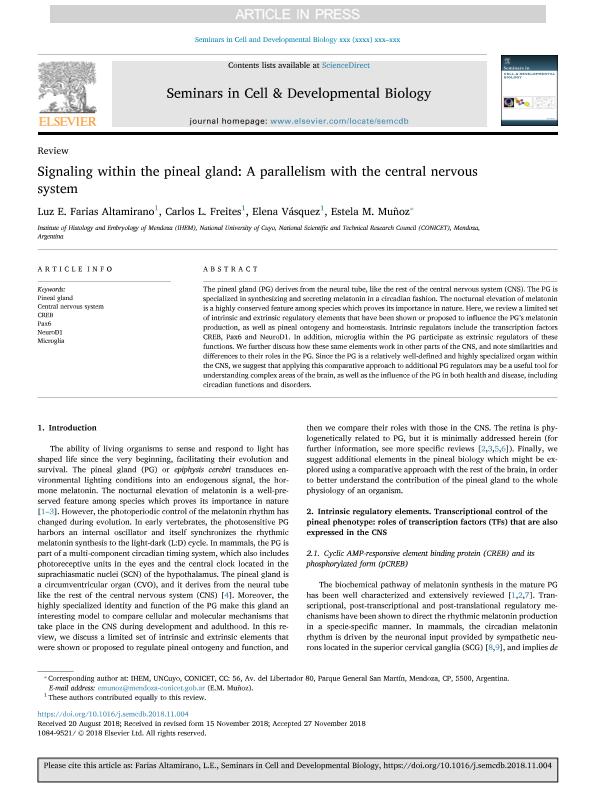Artículo
Signaling within the pineal gland: A parallelism with the central nervous system
Fecha de publicación:
12/2018
Editorial:
Academic Press Ltd - Elsevier Science Ltd
Revista:
Seminars In Cell & Developmental Biology
ISSN:
1084-9521
Idioma:
Inglés
Tipo de recurso:
Artículo publicado
Clasificación temática:
Resumen
The pineal gland (PG) derives from the neural tube, like the rest of the central nervous system (CNS). The PG is specialized in synthesizing and secreting melatonin in a circadian fashion. The nocturnal elevation of melatonin is a highly conserved feature among species which proves its importance in nature. Here, we review a limited set of intrinsic and extrinsic regulatory elements that have been shown or proposed to influence the PG's melatonin production, as well as pineal ontogeny and homeostasis. Intrinsic regulators include the transcription factors CREB, Pax6 and NeuroD1. In addition, microglia within the PG participate as extrinsic regulators of these functions. We further discuss how these same elements work in other parts of the CNS, and note similarities and differences to their roles in the PG. Since the PG is a relatively well-defined and highly specialized organ within the CNS, we suggest that applying this comparative approach to additional PG regulators may be a useful tool for understanding complex areas of the brain, as well as the influence of the PG in both health and disease, including circadian functions and disorders.
Palabras clave:
CENTRAL NERVOUS SYSTEM
,
CREB
,
MICROGLIA
,
NEUROD1
,
PAX6
,
PINEAL GLAND
Archivos asociados
Licencia
Identificadores
Colecciones
Articulos(IHEM)
Articulos de INST. HISTOLOGIA Y EMBRIOLOGIA DE MEND DR.M.BURGOS
Articulos de INST. HISTOLOGIA Y EMBRIOLOGIA DE MEND DR.M.BURGOS
Citación
Farías Altamirano, Luz Estefanía; Freites, Carlos Leandro; Vásquez, Elena; Muñoz, Estela Maris; Signaling within the pineal gland: A parallelism with the central nervous system; Academic Press Ltd - Elsevier Science Ltd; Seminars In Cell & Developmental Biology; 12-2018; 1-9
Compartir
Altmétricas




